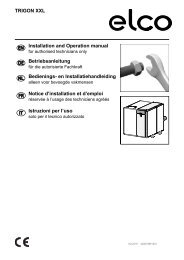Nimbus Compact M NET R32 Installation Manual UK
You also want an ePaper? Increase the reach of your titles
YUMPU automatically turns print PDFs into web optimized ePapers that Google loves.
Decommissioning<br />
8.2 Disposal<br />
The manufacturer is registered with the national EEE Register,<br />
in conformity to the implementation of Directive 2012/19/EU,<br />
and of the relative national regulations in force concerning<br />
waste electrical and electronic equipment.<br />
This directive recommends the correct disposal of waste electrical<br />
and electronic equipment.<br />
Equipment bearing the crossed-out wheelie bin symbol must<br />
be disposed of at the end of its life and sorted to avoid detrimental<br />
effects on human health and on the environment.<br />
Electrical and electronic equipment must be disposed of together<br />
with all its constituent parts.<br />
To dispose of “domestic” electrical and electronic equipment,<br />
the manufacturer recommends contacting an authorised dealer<br />
or an authorised ecological facility.<br />
The disposal of “professional” electrical and electronic equipment<br />
must be made by authorised personnel through the specially<br />
instituted local consortiums.<br />
To this aim, we include below the definition of domestic WEEE<br />
and professional WEEE.<br />
WEEE deriving from households: WEEE deriving from<br />
households and WEEE deriving from commercial, industrial, institutional<br />
and other sources, similar by nature and quantity, to<br />
that deriving from households. WEEE that could be used both<br />
by households and by other types of users are nonetheless regarded<br />
as WEEE coming from households;<br />
Professional WEEE: all WEEE other than that coming from<br />
households as mentioned above.<br />
This equipment may contain:<br />
– Refrigerant gas that must be fully recovered by specialised<br />
personnel and accompanied by the necessary authorisations<br />
in special containers;<br />
– Lubricant oil contained in compressors and in the refrigeration<br />
circuit that must be collected;<br />
– Mixtures with anti-freeze liquids contained in the water<br />
supply distribution network, the contents of which<br />
must be appropriately collected;<br />
– Mechanical and electrical parts that must be sorted and<br />
disposed of in an authorised manner.<br />
When machine components are removed for being replaced<br />
for maintenance purposes or when the entire unit reaches the<br />
end of its life and must be removed from the installation, we<br />
recommend sorting the waste according to type and ensuring<br />
that it is disposed of by authorised personnel at the existing<br />
waste collection facilities.<br />
Fig. 95<br />
EN / 79

















